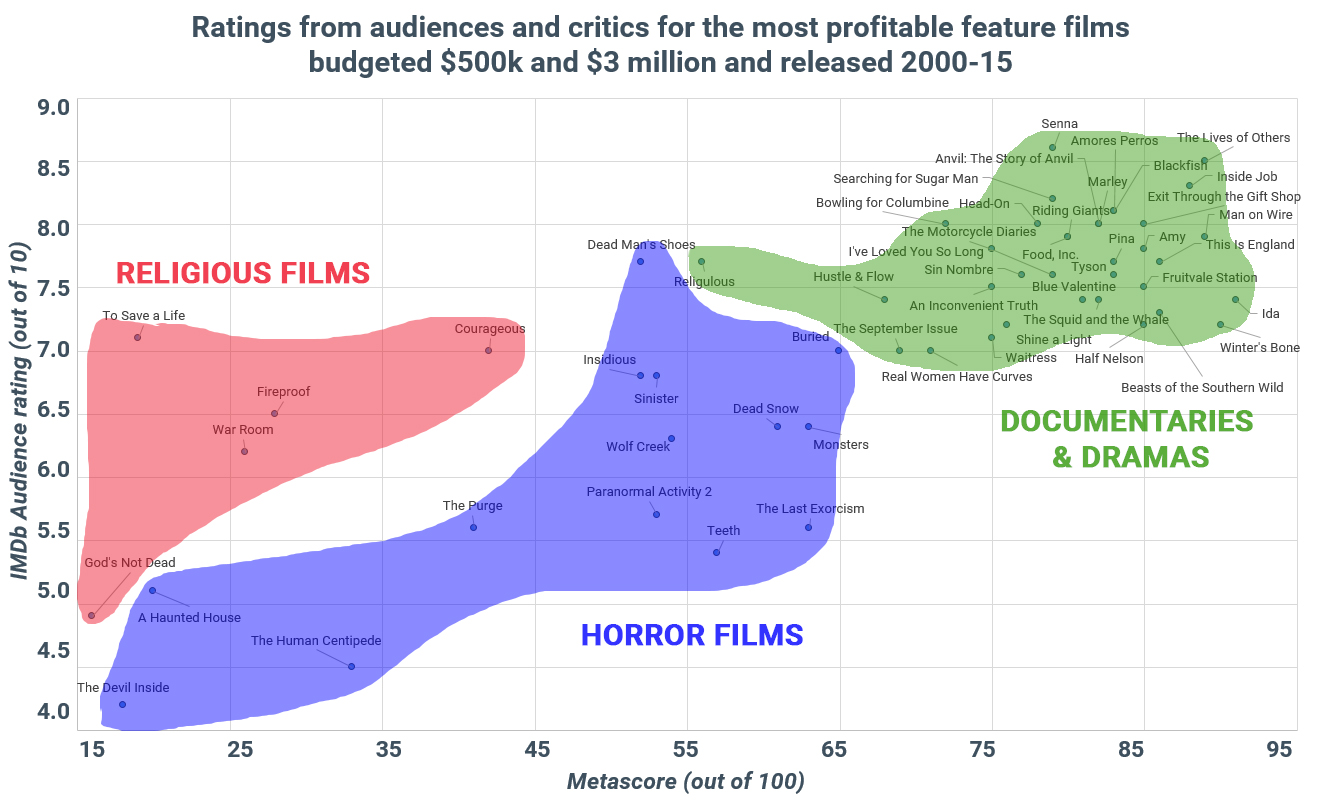WHAT TYPES OF LOW-BUDGET FILMS BREAK OUT?
An investigative report from Film Industry Analyst Stephen Follows and Founder of The Numbers Bruce Nash
Breakout indie hits may be some of the most romantic stories in the movie business. The plucky lone film-maker battles the odds to make their dream film, putting naysayers in their place when it becomes a box office sensation, bringing them fame and fortune beyond their wildest dreams…
But are breakout hits random events that no-one can plan for or do they share some kind of DNA that can teach us how to make successful independent films, and also what genres or techniques to avoid?
To answer these questions, we began with a list of over 3,000 films from The Numbers’ financial database, investigating full financial details, including North American (i.e. “domestic”) and international box office, video sales and rentals, TV and ancillary revenue. We narrowed our focus to study feature films released between 2000 and 2015, budgeted between $500k and $3 million, which generated at least $10 million in Producer’s Net Profit, using a standard distribution model where the distributor charges a 30% fee.
This produced a list of 63 films in total: roughly four films a year over the 15 years under consideration. Almost all of the movies will be familiar to followers of independent film, from small films that became Oscar hopefuls, like Beasts of the Southern Wild and Winter’s Bone to horror movies like Insidious and The Purge that got picked up by the major studios and became box office sensations. With the list in hand, we looked for common themes and found (with a small number of exceptions) that the breakout hits broke down naturally into four types.
Model One: Extreme, Clear-Concept Horror Films
It will come as no surprise to most producers that horror films feature prominently on the list of top low-budget breakout successes.

- Most Profitable Films: Insidious, Monsters, The Devil Inside, Paranormal Activity 2, Dead Snow.
- MPAA Rating: 82% are rated ‘R’, 12% PG-13 and 6% not rated.
- Running Time: Relatively short, with an average of 94 minutes and no film ran over two hours.
- Critical Reviews: Average to poor. Highest rated film in this category is Buried, which has a Metascore of just 65 out of 100. The average Metascore across the dataset was just 49 out of 100.
- Audience Reviews: More supportive than the critics, but still not above average for most films, at an average of 6.2 out of 10 on IMDb.
- Release Patterns: Two very distinct release patterns – half played in fewer than around 100 theatres while the other half played in over 1,500 theatres.
- Income Streams: 28% from theatrical, 60% from home video and 11% from TV and other ancillary income.
- Income Location: 46% of income was from the US & Canada and 54% international.
Model Two: Documentaries with Built-In Audiences and/or Powerful Stories
The second group of films that stood out were documentaries.

- Most Profitable Films: Exit Through the Gift Shop, An Inconvenient Truth, Marley, Tyson, Bowling for Columbine.
- MPAA Rating: A healthy spread across all ratings, with the most common being PG-13.
- Running Time: Average of 102, although a wide range from 80 minutes up to 144 minutes.
- Critical Reviews: Very high, with a Metascore average of 79 out of 100.
- Audience Reviews: Very high, an average IMDb rating of 7.8 out of 10.
- Release Pattern: Small number of theatres, with most playing in under 250 theatres and the widest release being An Inconvenient Truth in 587 theatres.
- Income Streams: 17% from theatrical, 71% from home video and 12% from TV and other ancillary income.
- Income Location: 58% international and 42% domestic.
Critical reviews seem vital for this type of film to break out and it’s interesting to note that the documentaries with the lowest scoring critical ratings (The September Issue at 69 and Religulous at 56) each had strong inbuilt audiences (‘Vogue / fashion’ and ‘Bill Maher / religious skepticism’).
In fact, only a handful of the documentaries on the list don’t have an obvious audience: Man on Wire, Anvil: The Story of Anvil, and Searching for Sugar Man are the only ones that needed to find a crowd. The others were either about someone already very famous (Marley, Tyson, Senna, Amy… note the one-name titles!) or played very directly to a receptive audience (Inside Job, Blackfish, An Inconvenient Truth etc.).
Model Three: Validating, Feel-Good Religious Films
Speaking of receptive audiences, the third group of films we found were faith-based films.

- Most Profitable Films: Fireproof, God’s Not Dead, To Save a Life, War Room, Courageous.
- MPAA Rating: Two-thirds were rated PG and the remaining third were PG-13.
- Running Time: Fairly long, all were over 110 minutes and the average was two hours.
- Critical Reviews: Incredibly poor, with an average Metascore of just 26 out of 100.
- Audience Reviews: Similar to the horror pool, with an average IMDb rating of 6.3 out of 10.
- Type of Release: An average of 1,273 theatres with the widest being War Room at 1,945 theatres.
- Income Streams: 29% from theatrical, 55% from home video and 16% from TV and other ancillary income.
- Income Location: 90% of income came from North American sources with just 10% coming from outside the US and Canada.
Two things stand out with these films. First, they make virtually all of their money in the United States. Second, they get very bad reviews from mainstream movie reviewers. The strength of these movies isn’t necessarily their quality so much as the message; they deliver to an audience that is interested in what they have to say.
Model Four: Very High Quality Dramas
At the other end of the spectrum, at least in the eyes of professional film reviewers, come very high quality dramas. Almost half of these films were American productions, with the rest coming from a wide variety of countries including Germany, Argentina, Mexico, the UK, France and Poland.

- Most Profitable US Dramas: Half Nelson, Waitress, Blue Valentine, Fruitvale Station.
- Most Profitable Foreign Dramas: The Lives of Others, The Motorcycle Diaries, Amores Perros, Sin Nombre.
- MPAA Rating: The vast majority are R-rated, with just a third being rated PG-13.
- Running Time: A wide range, from 81 minutes up to 154 minutes long.
- Critical Reviews: Extremely high, with an average Metascore of 81 out of 100.
- Audience Reviews: Similarly high, with an average IMDb rating of 7.5 out of 10.
- Type of Release: Small release, with all but four playing to fewer than 300 theatres.
- Income Streams: 25% from theatrical, 63% from home video and 12% from TV and other ancillary income.
- Income Location: 66% of income for US dramas came from the US and Canada, whereas the reverse was true with non-US dramas, with 64% of income coming from international sources.
The lowest rated film in this category received a Metascore of 68 out of 100, which was higher than all of the films within the Horror breakout success category.
A common thread among these films is awards attention. While they might not be big enough to win a lot of main-category Oscars, these are the films that have picked up a bunch of Independent Spirit Awards, Best Foreign Language Film at the Academy Awards, and got some screenwriting and/or acting Oscar nominations.
Do the Films Have to be Any Good?
An interesting finding from this research is that the quality of the film is only relevant for certain types of films.
- Religious films received extremely low ratings from critics but had mixed ratings from audiences.
- Horror films showed a range: some were disliked by both audiences and critics (such as The Devil Inside), while others had middling support from both camps (such as Monsters) and then there were films which audiences enjoyed but critics were lukewarm towards (such as Dead Man’s Shoes).
- Documentaries and Dramas were all popular with audiences and the vast majority also received extremely high ratings from critics.
If we plot this on a graph, we can see just how distinct these three sub-categories are.

What’s Missing?
Many of the films in the list come as no surprise, but what’s interesting is what’s missing from the list. We found…
- Virtually no comedies (Waiting… is the only out-and-out comedy on the list, and it was made at the peak of the DVD sales boom)
- No action movies
- No thrillers
- No musicals
- Virtually nothing directed at kids — Dr. Dolittle 3 was the only family movie that made our list — although we believe some animated franchises such as Barbie are very profitable but their budgets aren’t quite in our range.
Aside from the missing genres, the other notable absence is any major star involvement. Of course, this is largely a function of the budget—it’s hard to get Tom Cruise for a $3 million film—but it’s remarkable that none of these films attracted anybody who would even be called a B-list star at the time the film was made.
Lessons for Filmmakers and Producers from this Research
So we think there are a few lessons for independent film-makers who are hoping to make breakout hits:
- Some “niche” audiences are large enough to make for a very profitable market, if you can reach them. The “faith-based” film audience stands out, but there are also receptive audiences for certain types of documentaries. Having a very clear idea of your audience is the first step to making a financially successful film.
- If you’re aiming for a more general audience, quality matters. A lot. Honing your screenplay to what you think is perfection and then having it ripped apart at a workshop may be hard work, but it’s almost certainly what it takes to get a dramatic film to ultimately work with audiences, and to make back its investment.
- Look for good actors, not big stars, and do the same with all of the technical crew on a film. Fun fact: Affonso Goncalves, who edited list member Beasts of the Southern Wild also edited fellow list member Winter’s Bone and 2016 Oscar nominee Carol. Finding a good editor, cinematographer, production designer and other key members of the crew is more important for a low-budget film than blowing a big chunk of your budget on a famous (or, just as likely, previously-famous) actor or actress.
The Full List of Films
This analysis looked at feature films released between 2000 and 2015 budgeted between $500k and $3 million and which we estimate generated at least $10 million in Producer’s Net Profit. The films which fit our criteria are listed below.
| RANK | FILM TITLE | YEAR | METASCORE | IMDB RATING | ESTIMATED BUDGET |
|---|---|---|---|---|---|
| 1 | Bowling for Columbine | 2002 | 72 | 8 | $3,000,000 |
| 2 | The Lives of Others | 2006 | 89 | 8.5 | $2,000,000 |
| 3 | War Room | 2015 | 26 | 6.2 | $3,000,000 |
| 4 | God's Not Dead | 2014 | 16 | 4.9 | $1,150,000 |
| 5 | An Inconvenient Truth" | 2006 | 75 | 7.5 | $1,000,000 |
| 6 | Garden State | 2004 | 67 | 7.6 | $2,500,000 |
| 7 | Insidious | 2010 | 52 | 6.8 | $1,500,000 |
| 8 | Fireproof | 2008 | 28 | 6.5 | $500,000 |
| 9 | Paranormal Activity 2 | 2010 | 53 | 5.7 | $3,000,000 |
| 10 | Hustle & Flow | 2005 | 68 | 7.4 | $2,800,000 |
| 11 | Waiting... | 2005 | 30 | 6.8 | $1,125,000 |
| 12 | Courageous | 2011 | 42 | 7 | $2,000,000 |
| 13 | Waitress | 2007 | 75 | 7.1 | $1,500,000 |
| 14 | The Motorcycle Diaries | 2004 | 75 | 7.8 | $3,000,000 |
| 15 | Exit Through the Gift Shop | 2010 | 85 | 8 | $500,000 |
| 16 | Man on Wire | 2008 | 89 | 7.9 | $1,900,000 |
| 17 | Dr. Dolittle 3 | 2006 | 3.9 | $3,000,000 | |
| 18 | Sinister | 2012 | 53 | 6.8 | $3,000,000 |
| 19 | Winter's Bone | 2010 | 90 | 7.2 | $2,000,000 |
| 20 | Blue Valentine | 2010 | 81 | 7.4 | $1,000,000 |
| 21 | This Is England | 2006 | 86 | 7.7 | $2,380,000 |
| 22 | [Rec] | 2007 | 7.5 | $2,100,000 | |
| 23 | Amores Perros | 2000 | 83 | 8.1 | $2,000,000 |
| 24 | The Last Exorcism | 2010 | 63 | 5.6 | $1,800,000 |
| 25 | Shine a Light | 2008 | 76 | 7.2 | $1,000,000 |
| 26 | Monsters | 2010 | 63 | 6.4 | $1,000,000 |
| 27 | The Squid and the Whale | 2005 | 82 | 7.4 | $1,500,000 |
| 28 | The Purge | 2013 | 41 | 5.6 | $3,000,000 |
| 29 | Senna | 2010 | 79 | 8.6 | $1,000,000 |
| 30 | The September Issue | 2009 | 69 | 7 | $1,000,000 |
| 31 | The Devil Inside | 2012 | 18 | 4.2 | $1,000,000 |
| 32 | Riding Giants | 2004 | 80 | 7.9 | $2,600,000 |
| 33 | Half Nelson | 2006 | 85 | 7.2 | $700,000 |
| 34 | Buried | 2010 | 65 | 7 | $1,987,650 |
| 35 | Pina | 2011 | 83 | 7.7 | $1,000,000 |
| 36 | Head-On | 2004 | 78 | 8 | $2,500,000 |
| 37 | The Hidden Face | 2011 | 7.4 | $2,600,000 | |
| 38 | Sin Nombre | 2009 | 77 | 7.6 | $2,000,000 |
| 39 | Fruitvale Station | 2013 | 85 | 7.5 | $900,000 |
| 40 | Inside Job | 2010 | 88 | 8.3 | $2,000,000 |
| 41 | Amy | 2015 | 85 | 7.8 | $2,750,000 |
| 42 | To Save a Life | 2009 | 19 | 7.1 | $500,000 |
| 43 | Marley | 2012 | 82 | 8 | $500,000 |
| 44 | Religulous | 2008 | 56 | 7.7 | $2,500,000 |
| 45 | Real Women Have Curves | 2002 | 71 | 7 | $3,000,000 |
| 46 | Wolf Creek | 2005 | 54 | 6.3 | $1,100,000 |
| 47 | Tyson | 2008 | 83 | 7.6 | $500,000 |
| 48 | Teeth | 2007 | 57 | 5.4 | $2,000,000 |
| 49 | Food, Inc. | 2008 | 80 | 7.9 | $1,000,000 |
| 50 | Dead Man's Shoes | 2004 | 52 | 7.7 | $1,125,000 |
| 51 | Dog Soldiers | 2002 | 6.9 | $3,000,000 | |
| 52 | I've Loved You So Long | 2008 | 79 | 7.6 | $2,500,000 |
| 53 | The Human Centipede (First Sequence) | 2009 | 33 | 4.5 | $1,850,000 |
| 54 | Beasts of the Southern Wild | 2012 | 86 | 7.3 | $1,800,000 |
| 55 | Anvil: The Story of Anvil | 2008 | 82 | 8 | $500,000 |
| 56 | Enron: The Smartest Guys in the Room | 2005 | 7.7 | $750,000 | |
| 57 | Blackfish | 2013 | 83 | 8.1 | $750,000 |
| 58 | Half Light | 2006 | 6 | $2,400,000 | |
| 59 | A Haunted House | 2013 | 20 | 5.1 | $2,500,000 |
| 60 | Ida | 2013 | 91 | 7.4 | $2,750,000 |
| 61 | Is Anybody There? | 2008 | 54 | 6.8 | $2,500,000 |
| 62 | Searching for Sugar Man | 2012 | 79 | 8.2 | $500,000 |
| 63 | Dead Snow | 2009 | 61 | 6.4 | $800,000 |
Notes
- The financial figures come from a variety of sources, including people directly connected to the films, verified third-party data and computation models based on partial data and industry norms. It is possible that one or two of the individual figures are different to our predictions, though en masse we are confident of the larger picture.
- The number of theatres relates to the widest point of the film’s North American release.
About the Authors
Stephen Follows is a writer, producer and film industry analyst. His film research has been featured in the New York Times, The Times, The Telegraph, The Guardian, The Daily Mail, The Mirror, The Evening Standard, Newsweek, The News Statesman, AV Club and Indiewire. He acted as an industry consultant and guest on the BBC Radio 4 series The Business of Film, which topped the iTunes podcast chart, and has consulted for a wide variety of clients, including the Smithsonian in Washington. In addition to film analytics, Stephen is an award-winning writer-producer and runs a production company based in Ealing Studios, London.
Bruce Nash is founder and President of Nash Information Services, LLC, the premier provider of movie industry data and research services and operator of The Numbers, a web site that provides box office and video sales tracking, and daily industry news. Mr. Nash founded the company in 1997 and it now serves approximately 1,000 clients, from the major studios to first-time independent filmmakers. Mr. Nash provides regular commentary and analysis for media outlets, including the L.A. Times, the New York Times, Variety, the Wall Street Journal, 60 Minutes, and CBS News. Mr. Nash is the official adjudicator of movie records for the Guinness Book of Records. To learn more about his company’s services, visit Nash Information Services.
Copyright © 2021 Stephen Follows and Bruce Nash. All rights reserved. Reproduced with permission.
Explore more articles and research at Producers Resources.























